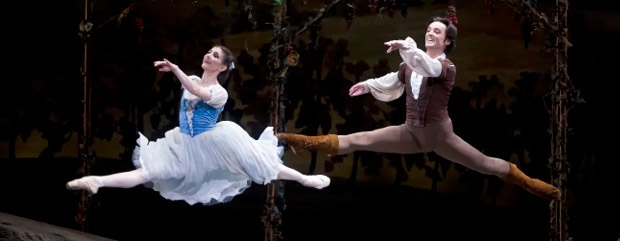
“Giselle” Redux
American Ballet Theatre
Giselle
New York, Metropolitan Opera House
17, 18 May 2012
www.abt.org
Unforgettable performances, the kind that leave us wobbly-kneed and bleary-eyed, are rare, and irreproducible. Unwisely, we try to re-capture the feeling; we seek out the same ballet, the same cast. Alas, there is no formula guaranteeing transcendance. Last year, I experienced two time-stopping performances of “Giselle” in a row during American Ballet Theatre’s Metropolitan Opera Season, with two different casts: Alina Cojocaru and David Hallberg one night, Diana Vishneva and Marcelo Gomes the next. (You can read about this extraordinary streak in my FasterTimes review).
It took me weeks to recover. So, as I went off to see “Giselle” at American Ballet Theatre on May 17, with Alina Cojocaru in the title role and Ángel Corella as her aristocratic suitor (Albrecht), I made a conscious effort to lower my expectations, and to look with fresh eyes. I’m glad I did. Not that it wasn’t a compelling performance – in many ways it was – but, at least for me, not one for the ages. But perhaps because I was not blinded by emotion, I could see more clearly the qualities that make Cojocaru such a mesmerizing performer (that touching sincerity combined with an intense engagement with her onstage world), and the innate skill with which she builds a character, sometimes using her own weaknesses to her advantage (wobbles as expressions of over-excitement). It also became very clear what will be missed when Ángel Corella leaves the company at the end of the season: his sweetness and warmth, his touching eagerness to please. He is quite simply the most loveable person onstage at all times. Hopefully, he will bring these qualities to his own company, Barcelona Ballet.
But charisma and craft of the dancers cannot guarantee perfection; the music must co-operate as well. The tempi in this performance, especially in the second act, were so eccentrically slow that is seemed the music might actually grind to a stop. (Who makes these decisions, I wonder?) The tension in this act is supposed build in an inexorable crescendo to the brink of exhaustion and death. This notion hardly registered. The famous advancing lines of avenging spirits (Wilis) chugging forward in arabesque, held no sense of menace, through no fault of their own. The variations for the two Wili soloists (Christine Shevchenko and Maria Riccetto), became tricky exercises in technique, with no musical energy to buoy them – nevertheless, they were well executed. The dancing, all around, was strong. Gillian Murphy’s turn as queen of the Wilis (Myrtha) was commanding, with powerful jumps, but a fuller use of her upper body would have made her more interesting. Sascha Radetsky’s Hilarion, the local huntsman whom Giselle rejects in favor of Albrecht, suffered the Wilis’ torment with great panache, pleading and throwing himself about desperately and looking increasingly like a broken marionette. (In the first act, he gives the role a rather brooding, thuggish quality; one is rather relieved that Giselle doesn’t want to marry him. He loves her desperately, but he would make a terrible husband.) The acting role of Bathilde (Albrecht’s betrothed) was played by the blindingly beautiful Luciana Voltolini, a member of the corps who was also very memorable last season as one of the stompers in Twyla Tharp’s “In the Upper Room.” After Albrecht’s deception was revealed, she shot him a glance of such withering contempt it was a marvel he didn’t shrivel up and die.
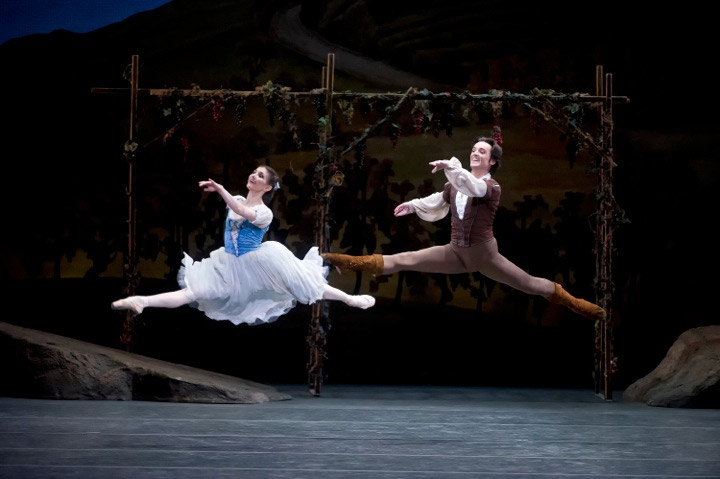
And what about the lovers? As one might expect, Cojocaru gave an intense, highly-detailed account of the role. In the first act, she had the lightness of a tightly-wound, delicate young girl, her balloné hops an expression of her almost feverish nervousness and excitement. One of her great talents is the ability to change physically in response to emotion; her complexion changes, the blood drains from her face, her elbows press to her sides. She has an interesting way of showing us the insides of her arms; their creamy whiteness speaks volumes about her vulnerability. She does not appear to be acting; it’s as if the world of her imagination were completely real. In the same way she interacts with the other people onstage as if they were experiencing the same reality, from Albrecht down to the little boys perched atop the grape harvesters’ cart. (One of those little boys was the adorable Justin Souriau-Levine, who played the mouse in Alexei Ratmansky’s “Nutcracker” last year. He seemed just as delighted as Cojocaru to be celebrating the grape harvest.) Her dancing was not as assured as in the performance I saw last year: she had a few wobbles and unsure balances, and didn’t always fill the music or travel as far as she might. But, even on a less-than-perfect night, it’s clear that what one gets from Cojocaru is not technical perfection – though she has a sprightly jump, a beautiful arabesque, and a breathtaking gliding bourré. But with her, the steps are sublimated into the character and the situation. She seems to be experiencing the ballet anew, moment by moment, with the audience. No surprise, then, that her mad scene is hypnotic, and changes from performance to performance. Last year, I remember how she went pale and limp and crumpled to the ground. This time, it was a harrowing business; from the very beginning of the scene, her face was ashen, hollow, her eyes crazed. She looked physically unwell. She rushed haphazardly, almost dangerously, around the stage. You almost wanted to look away.
Corella’s talents are of a different stripe. He was lovable from the moment he set foot onstage; one could see how a young girl would fall under his thrall. But Corella is incapable of projecting caddishness; when he tried to affect the willful attitude of a nobleman, he succeeded in looking priggish instead. His jump is not what it once was but his musicality and sense of play are intact. In the second act, his partnering was, as always, a model of generosity (even heroism, given the gooey tempo). His walk to Giselle’s grave was less solemn than some, and more poetic – he took great joy in showing the fluttering of his cape as he traced a circle around the stage. Corella is always a Romeo, at heart. In his final solo, he opted for two diagonals of traveling beaten jumps (brisés) toward Myrtha rather than the long sequence of entrechats preferred by most of ABT’s Albrechts . As he rushed headlong toward the queen of the Wilis, he never took his eyes off of her, pleading, “come on, give me a break!” It was sweet and a little bit funny (though Myrtha was not amused). In the ballet’s final moments, he did not crumple onto Giselle’s grave in despair, but wandered away, dreamily, as if finally at peace. Perhaps there was a glimmer of hope in the world, after all.
The following night (May 18), I saw a very different cast: Xiomara Reyes was Giselle, Herman Cornejo danced the role of Albrecht, and Devon Teuscher had her New York début in the role of Myrtha.
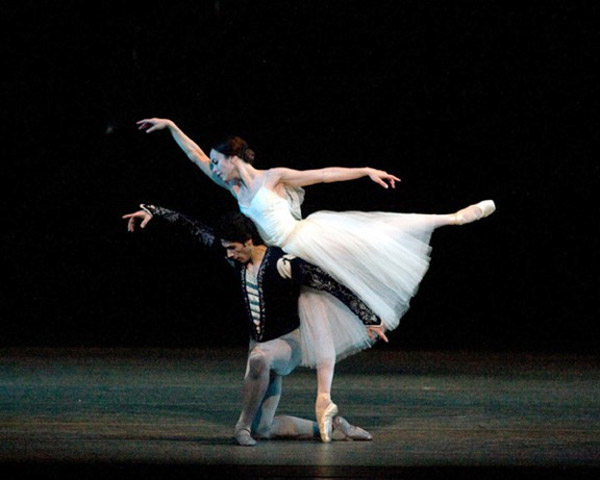
Reyes’s Giselle is well-crafted; after all, she was trained in Cuba, where “Giselle” is de rigueur. Her style is right, her technique more than sufficient (her turns are particularly impressive). Her interpretation of the first act is a bit generic – very girlish, very innocent – but the second act is touching and refreshingly unmannered. She gets all the details just right and succeeds where others fail: the difficult slow passage in which Giselle lifts one leg to the side and then carries it back into an arabesque penché was as smooth as I’ve ever seen it. From the beginning, though, Cornejo’s performance was on an altogether different level. He has a natural, unforced nobility (despite his small stature) and, in the first act, a rather rascally grin. He’s playful but sexy. The sense of birthright is very close to the surface. Yes, he’s charmed by Giselle but he’s also intent on getting what he wants no matter what the cost. (Perhaps this is why he is so remorseful in the second act; he knows just how guilty he is.) And then, there is the finesse of his dancing. The panther-like jumps, the clean, unforced taps of his legs in mid-air, the perfect landings, the well-controlled turns and beautifully pointed feet. He is certainly one of the finest male dancers around, and yet, one feels, he could give even more. His partnership with Reyes is too comfortable, too tame; they are more like brother and sister than young lovers. On May 28, he will dance in “La Bayadère” (for the first time with ABT) alongside Alina Cojocaru; now that should be interesting.
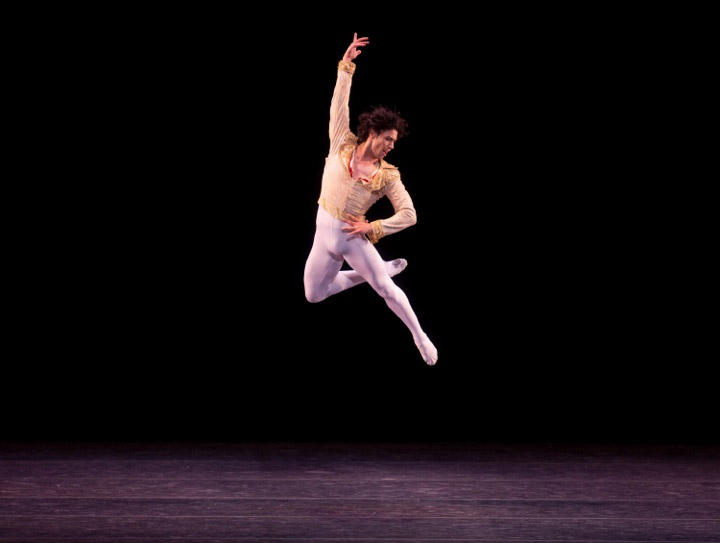
Three final notes on the May 18 performance: the tempi, though still on the slow side, were within the bounds of normalcy, thanks to the conducting of Charles Barker. (In fact, the evening was several minutes shorter). One of the highlights of the first act was Isabella Boylston’s dancing in the so-called “Peasant Pas de Deux,” with its music-hall-like accompaniment by Johann Friedrich Franz Burgmüller. Clean, stylish, musical, easygoing, and full of joy. Thanks to her, for once, this interlude was the delight it is meant to be. And Devon Teuscher made a very strong début as Myrtha, Queen of the Wilis. She was chilly and authoritative, but the coldness was laced with a vein of sadness. One could sense that she too had suffered a tragic past. Teuscher didn’t make the mistake of trying too hard to look mean, while never losing her focus and intensity. Her beautiful long arms and supple back complimented her wafting movements, magnifying the illusion of gliding through the air. The fact that she is still a member of the corps actually added to her interpretation; there was a sense of sistershood with the other Wilis. A very auspicious first step for this lovely young dancer.
“Giselle” continues through May 21, followed by Makarova’s “La Bayadère.”












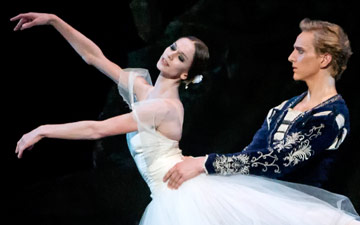

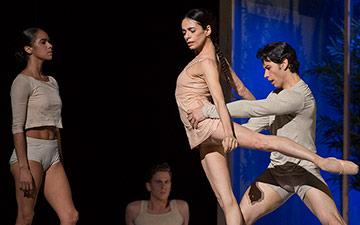
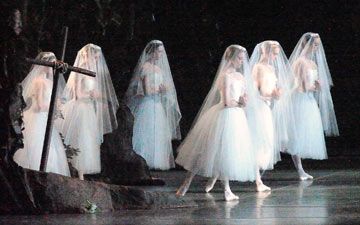

I am in strong agreement with the portion about the May 17th performance. It was moving and beautiful. I missed the May 18th performance. I was totally delighted and mesmerized by the matinee performance on May 19. Natalia Osipova, David Hallberg and Stella Abrera were wonderful. I feel so lucky to have been able to be delighted by both appearances.
I will sorely miss Angel Corella’s principal dancer’s performances.
I am delighted to see that David Hallberg has grown so much since I last saw him dance in the 2010 season.
Dear Barbara,
Cojocaru and Hallberg were stunning last year when they danced Giselle together. He is, contrary to his appearance, an almost feral dancer, always pushing to the limit. I’ll never forget the look in his eye when Giselle died–utter panic. Or his entrechats in the second act–it seemed as if he was being compelled to go on by an demonic external force. Terrifying.
I saw Natalia Osipova in the role 2 years ago, I think, and found her spectacular, but a tad forced in her acting. I’m sure she has probably improved enormously since then. She’s such a powerful, adaptable dancer. Grabs hold of a role and doesn’t let go.
Thanks for writing!
M
Regarding the tempi — Even act I sounds a bit slow during the Osipova/Hallberg performance. Meanwhile over at City Ballet, the 4th movement of the Symphony in C I saw proceeded at a break neck speed. I hope the conductors are reading your reviews.